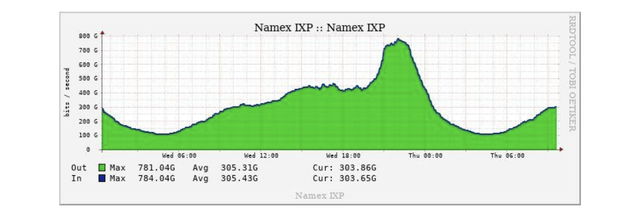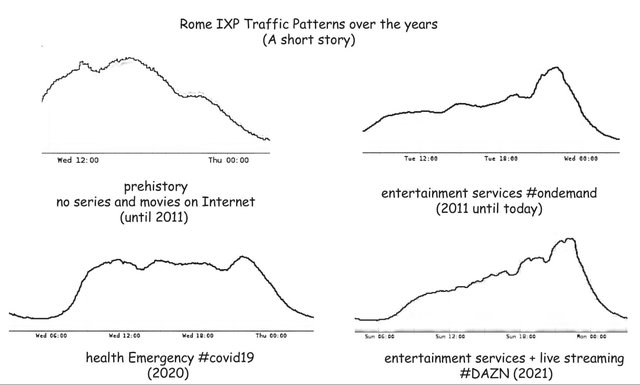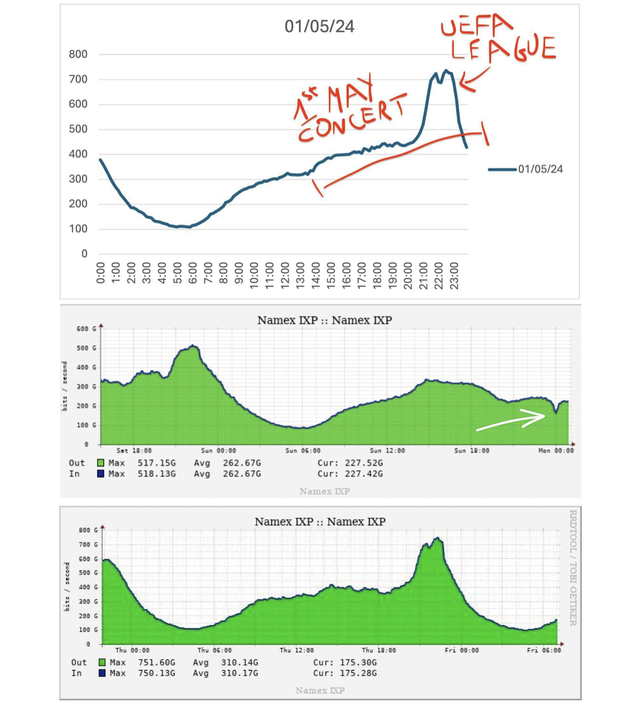IXPs are the airports of the Internet, busy hubs connecting traffic from a multitude of networks. The Namex observatory provides a unique view of the health and stability of the Internet as it continues to grow and evolve.
Monitoring Internet traffic at exchange points is a long-standing operational practice - it is essential for several reasons related to the stability, security, and efficiency of the entire Internet infrastructure.
Monitoring allows for the quick identification of any congestion or bottlenecks, thus optimising performance and ensuring a faster and more reliable connection. Additionally, it is essential for security. It helps detect suspicious activities, such as cyberattacks or abnormal data flows, enabling a prompt response to prevent disruptions or damage.
Monitoring is also crucial for planning network capacity expansion, allowing operators to anticipate traffic growth and prepare adequate infrastructure. Furthermore, in case of failures or technical issues, constant monitoring enables quick detection and resolution of the incident, minimising the impact on users.
Finally, the data collected is also valuable for research and innovation, providing useful insights to study the evolution of the network and develop new technologies.
In summary, Internet traffic reflects the health not only of the IXPs, but of the entire Internet infrastructure. Active and continuous monitoring, therefore, becomes a priority for those operating the exchange.

NOTE: The image above shows the typical Internet traffic graph of an IXP. The vertical axis represents the unit of measurement for data transmission speed (Gbps, Gigabits per second), while the horizontal axis shows the timeline (the last 24 hours). Data is collected at regular intervals, typically every 5 minutes. Along with this daily graph, the weekly, monthly, and yearly graphs are often displayed as well. When referring to traffic peaks, it means the highest value in a given time frame. In the image above, for example, the Internet traffic peak is 784.04 Gbps.
Although Namex has always counted the bits passing through its interconnection infrastructure since its inception, the real monitoring activity began in 2011 with the arrival of the first Content Providers (CP) and Content Delivery Networks (CDN) at the Rome exchange point. This is because, from 2011, a significant increase in Internet traffic in Rome began, and consequently, the need for monitoring became crucial for analysing the impact of this traffic.

But how has traffic changed over the years in Italy?
In the early 2000s, most Internet traffic passed between traditional Internet Service Providers (ISPs). As the web grew, Content Providers became increasingly important. However, content distribution was often slow and inefficient because servers were concentrated in a few central locations, often far from users.
This scenario led to the rise of the first Content Delivery Networks, which began interconnecting with IXPs to distribute content closer to end users. The goal was to reduce latency and improve the quality of the browsing experience. This resulted in a significant increase in traffic at IXPs, but the traffic was mostly distributed and not heavily concentrated on a few providers.
With the advent of streaming services like Netflix, YouTube, and Amazon Prime Video, Internet traffic at IXPs underwent a radical change. CDNs and content providers became dominant, as high-definition videos started to make up the majority of the traffic.
Gradually, traffic became significantly concentrated on a few major players, mainly those distributing video content. This pushed IXPs to manage an increasing amount of data and to ensure low latency to meet the demands of an ever-growing audience of video consumers.
The COVID-19 pandemic marked a turning point for Internet traffic, especially at IXPs. With the introduction of lockdown measures and the spread of remote work, e-learning, and social distancing, there was an unprecedented surge in demand for online services. IXPs recorded exceptional traffic peaks, with increases in some regions reaching 40-60% higher than pre-pandemic levels. During this period, the infrastructure of networks and IXPs proved to be resilient, but the growth in traffic forced many of them to rapidly expand their capacity.
In recent years, live streaming services like DAZN and Prime Video, which broadcast live sporting events, including football leagues like Serie A and the UEFA Champions League, have added a new dimension to traffic management at IXPs. Live sports events require the availability of a large amount of bandwidth in real time, and the traffic generated is extremely concentrated in short time windows (literally the duration of a match).

This has led to new traffic peaks at IXPs, especially during major international events. The unpredictable and massive nature of this type of traffic has pushed IXPs to further improve their infrastructures to better manage these high-pressure moments. Additionally, the ever-increasing quality of video broadcasts, such as 4K or even 8K streaming, has further increased the demand for bandwidth.

Over the years, Internet traffic at IXPs has evolved from being predominantly an exchange between ISPs to one dominated by large content providers and CDNs, with an increasing focus on video streaming. The COVID-19 pandemic accelerated this trend, leading to an unprecedented rise in traffic. Finally, live streaming services for sporting events, such as DAZN and Prime Video, have further changed the landscape, introducing new challenges in managing extremely high and concentrated traffic peaks in short periods of time. IXPs have responded by expanding their capacity and optimising their infrastructures to meet these new demands.
As mentioned, over the years there have been several interesting events visible in the IXP traffic graphs, which have often reflected new social behaviours. Significant events observed include everything from the May Day concert and the Sanremo Festival to the Paris 2024 Olympics, as well as traffic drops due to New Year's Eve celebrations and Italy's matches broadcast on RaiPlay.

The need for Internet traffic monitoring led Namex to establish and organise an observatory, which today represents one of the key components of its infrastructure and a valuable service for affiliated operators - the Namex Observatory.
The constant analysis of traffic passing through the Namex network results in fewer incidents and saturation episodes during major events and serves as a guide for operators in planning infrastructure capacity increases. Internet traffic graphs also reflect our social behaviour and how the use of the Internet culturally changes, and this, if you will, is the most interesting (and often funny) aspect to analyse!
The Namex Observatory is open to all other IXPs, network operators, CDNs, and Content Providers who wish to contribute. We invite everyone to participate by sharing their interesting Internet traffic graphs and relevant data, which could be useful to the entire community. The goal is to promote collaboration and enhance the understanding of Internet traffic trends for the full benefit of the entire industry.





Comments 0